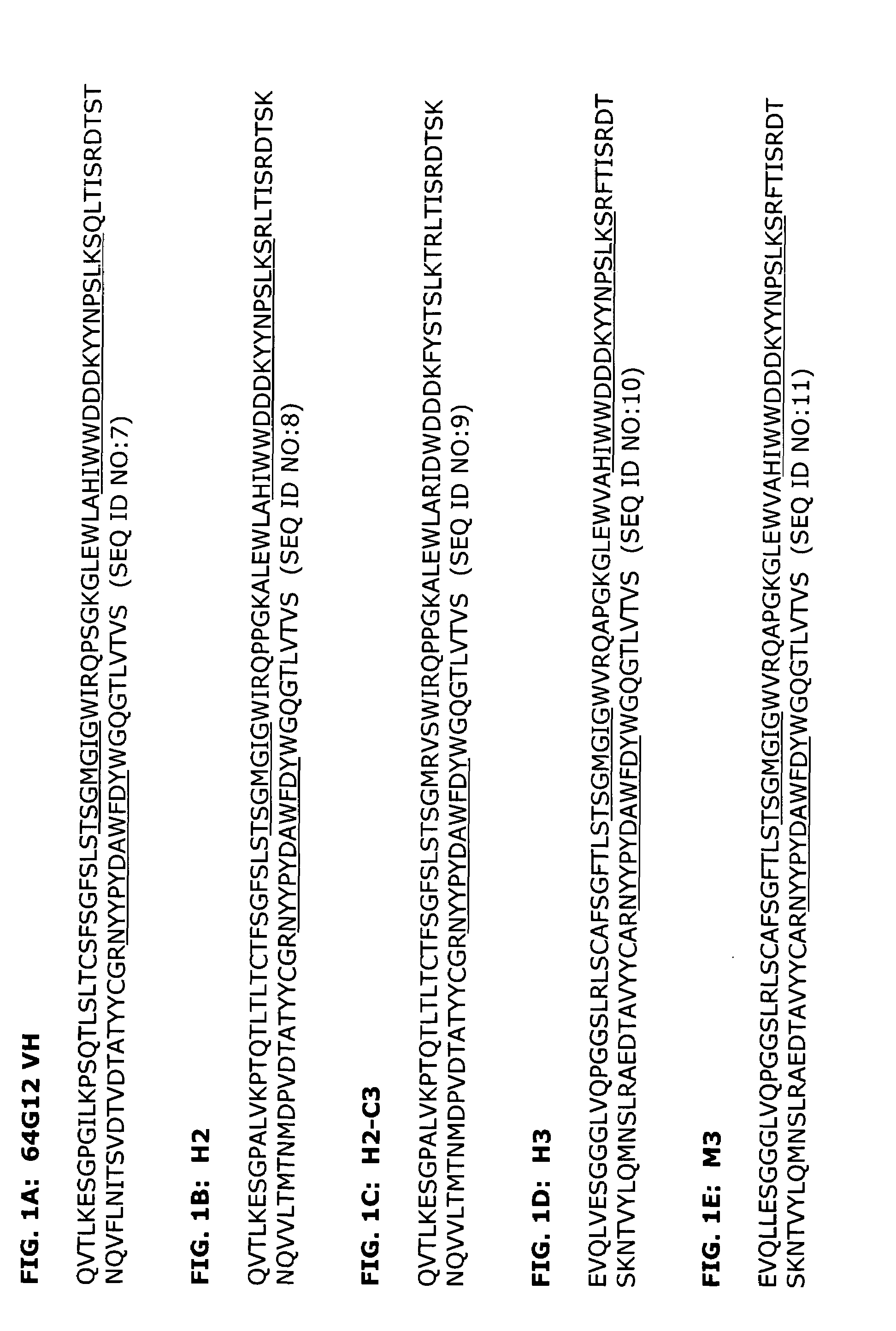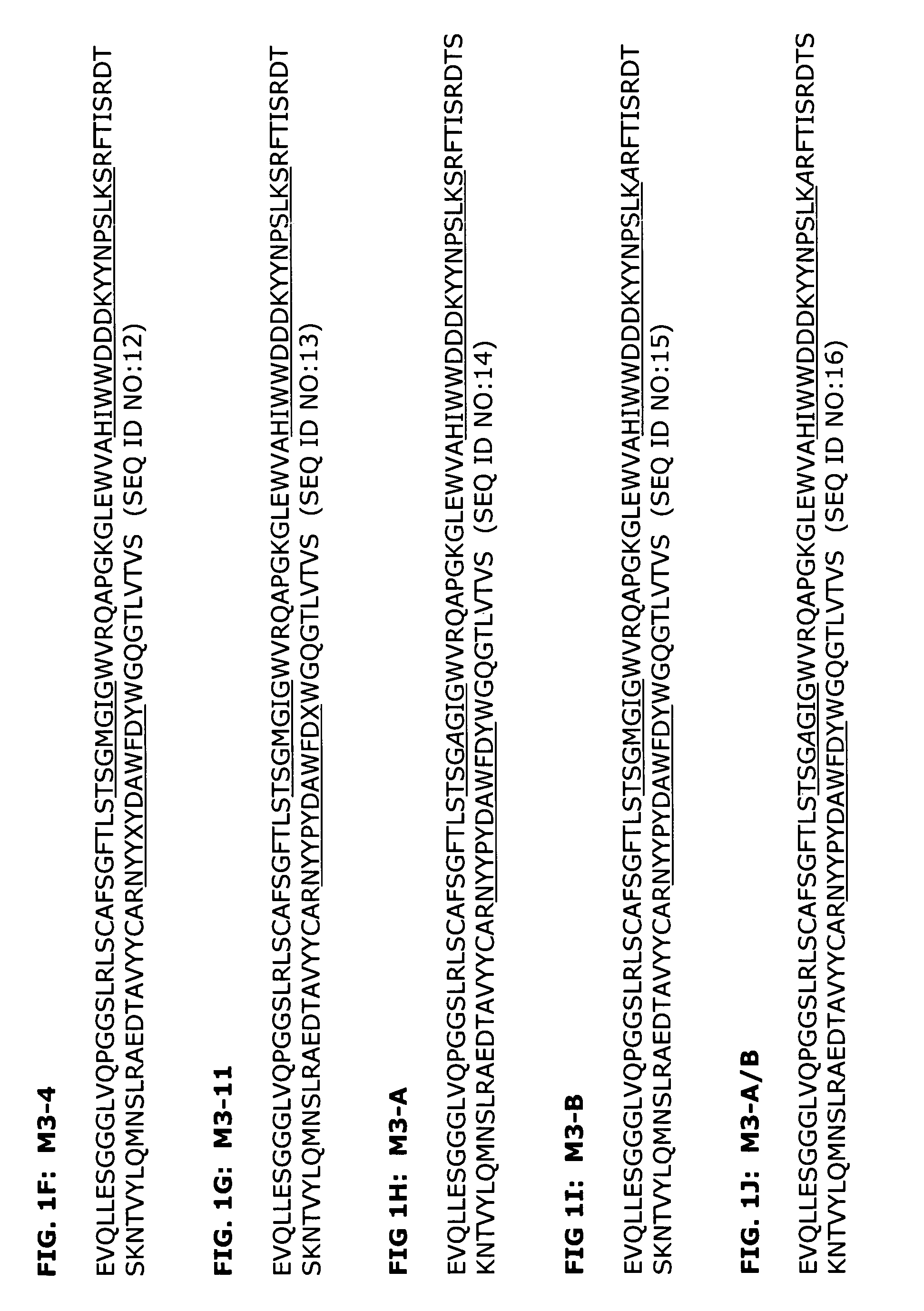Humanized antibodies to interferon alpha receptor-1 (IFNAR-1)
a technology of humanized antibodies and interferon alpha receptors, which is applied in the field of humanized antibodies to interferon alpha receptors (ifnar1), can solve the problems of fever and neurological disorders, unsatisfactory side effects,
- Summary
- Abstract
- Description
- Claims
- Application Information
AI Technical Summary
Problems solved by technology
Method used
Image
Examples
example 1
Production of Humanized Antibodies Specific for IFNAR-1
[0161]The source of the donor CDRs used to prepare the humanized antibody was a murine monoclonal antibody, 64G12, which is specific for IFNAR-1 (U.S. Pat. No. 5,919,453). A 64G12 hybridoma cell line was previously established.
Cloning of 64G12 Variable Regions
[0162]mRNA was extracted from the 64G12 hybridoma using Qiagen's Oligotex mRNA Miniprep Kit and the subsequent cDNA was synthesized using Clontech's Marathon cDNA Amplification Kit. The variable regions for the heavy chains of 64G12 were amplified with Qiagen's HotStarTaq using primers against the murine IgG1 gene (Forward: ATGGGCAGACTTACATTCTCATTCCTG (SEQ ID NO:43) and Reverse: CAGTGGATAGACAGATGGGG) (SEQ ID NO:44) while the light chains were amplified using primers against the murine kappa gene (ACTGGATGGTGGGAAGATGG) (SEQ ID NO:45) and the N-terminal amino acid sequence (CTCACCCAGTCTCCAACCACCATGGCTGCATC) (SEQ ID NO:46). The identity of the chains was confirmed by comparing...
example 2
Biacore Analysis of Certain Humanized VH and VL Pairings
[0196]A series of humanized antibody VH and VL pairings were produced and compared to the original murine antibody, as well as a mouse-human chimeric antibody which contained the murine variable regions from 64G12 and human IgG4 kappa constant regions. Human heavy chains H2 and H3 were expressed in combination with human light chains K1 and K6 to make the antibodies H2K6, H2K1, H3K6 and H3K1. The amino acid sequences of these variable regions are shown in FIGS. 1B, 1D, 2B, and 2C.
[0197]Antibodies from clones 64G12, H2K6, H2K1, H3K6, and H3K1 were assayed by Biacore analysis (Biacore AB, Uppsala, Sweden) to determine binding kinetics. Purified recombinant IFNAR-1 extracellular fragment was coupled to the CM5 sensor chip @ 600 RU. Binding was measured by adding antibody at concentrations from 1.75-80 nM at a flow rate of 20 ul / min. The binding curves were fit to a Langmuir binding model using BIAevaluation software (Biacore AB, U...
example 3
Deimmunization of Selected Antibody Sequences
[0203]The H3K1 VH and VK sequences were analyzed using a Peptide Threading program (Biovation, Inc.). Briefly, the amino acid sequences are divided into all possible 13-mers. The 13-mer peptides are sequentially presented to the modules of the binding groove of the HLA-DR allotypes and a binding score assigned to each peptide for each allele. A conformational score is calculated for each pocket-bound side chain of the peptide. This score is based on steric overlap, potential hydrogen bonds between peptide and residues in the binding groove, electrostatic interactions and favorable contacts between peptide and pocket residues. The conformation of each side chain is then altered and the score recalculated.
[0204]Potential T cell epitopes are removed by making amino acid substitutions in the particular peptide that constitutes the epitope. Substitutions were made by inserting amino acids of similar physicochemical properties if possible. Howe...
PUM
| Property | Measurement | Unit |
|---|---|---|
| dissociation constant | aaaaa | aaaaa |
| pH | aaaaa | aaaaa |
| biological spectrum | aaaaa | aaaaa |
Abstract
Description
Claims
Application Information
 Login to View More
Login to View More - R&D
- Intellectual Property
- Life Sciences
- Materials
- Tech Scout
- Unparalleled Data Quality
- Higher Quality Content
- 60% Fewer Hallucinations
Browse by: Latest US Patents, China's latest patents, Technical Efficacy Thesaurus, Application Domain, Technology Topic, Popular Technical Reports.
© 2025 PatSnap. All rights reserved.Legal|Privacy policy|Modern Slavery Act Transparency Statement|Sitemap|About US| Contact US: help@patsnap.com



